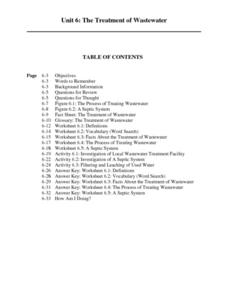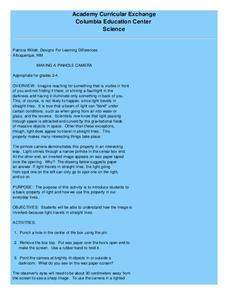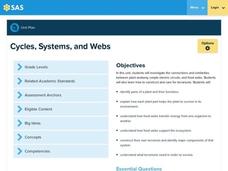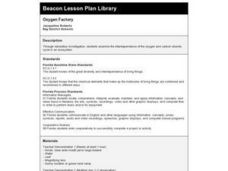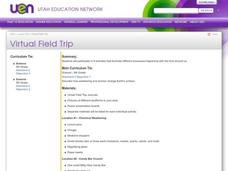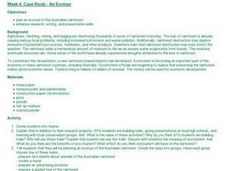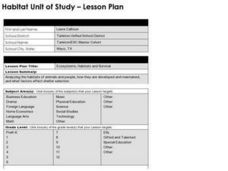Curated OER
The Treatment of Wastewater
Students, through a series of lessons, study the various processes of treating wastewater. They participate in discussion and complete various worksheets and a hands-on activity, in which they observe the processes of filtration and...
Curated OER
Modeling an Oil Reserve
Students conduct an experiment. In this oil and natural gas lesson, students learn how geoscientists identify and explore reserves of petroleum. Students make a model of an oil reserve, record how much it would cost to drill...
Curated OER
Breaking News: Shopping Carts Covered in Bacteria (5th March, 2011)
Students explore current events by completing several worksheet activities. In this bacteria infections lesson, students read a current news story of the germs associated with shopping carts and how people should protect themselves....
Pennsylvania Department of Education
The Digestive System
Fourth graders simulate how the digestive system works. In this hands-on simulation, 4th graders complete six group activities that help students visualize how our body breaks down food into nutrients.
Curated OER
Making a Pinhole Camera
Learners construct a pinhole camera in order to explain the basic property of the inversion of light. A well-designed and effective activity.
Curated OER
Hot n' Cold
Students keep a weather log. In this weather and temperature lesson, students discuss the information that can be obtained from a map and lead into a discussion about temperature. Students watch a video about temperature and...
Curated OER
Beauty: Patterns in Nature
Young scholars explore the patterns of nature. In this interdisciplinary lesson plan, students examine beauty in nature and participate in a hands-on simulation that demonstrates how human preferences for beauty have led to an increased...
Pennsylvania Department of Education
Cycles, Systems, and Webs
Fourth graders review the parts of the plant and their functions. In this plant lesson, 4th graders recognize that plants must transfer energy to make food. Students understand the interdependence of organisms in an...
Curated OER
Gifts from the Sea
Students investigate parts of the ocean. In this seaweed instructional activity, students identify foods that contain seaweed, parts of seaweed, and how the ocean affects our lives. As a class students brainstorm ways we rely on the...
Curated OER
What Do We Need In Our Environment To Survive?
Students discuss and write about waste management to save the environment. For this environment lesson, students discuss what an alien coming to Earth would notice about the environmental needs of humans for survival. They pretend that...
Curated OER
Insect Conservation
Learners make a diorama. In this insect lesson, students review what they know and what they need to know about insects. Learners define conservation, discuss why it is important to conserve insects, and make an insect diorama.
Curated OER
Where is Agriculture?
Students explore agriculture. In this agriculture lesson, students read "Where is Agriculture?" and discuss all the things that come from agriculture. Students discuss what they need to survive and give examples of agricultural products...
Curated OER
A Symphony of Decomposers
Students discover decomposition. In this environmental lesson, students explore different types of decomposers and their role within the ecosystem. Students also discover how waste interferes with the decomposition process.
Curated OER
Not Just a Fish Tank
Students learn about a specific species of fish, study the effects of outside substances on the reproductive development of a fish, and explore the process of a wastewater treatment facility.
Curated OER
DOWNHILL DISCOVERIES
Students studykinetic energy, friction, drag and acceleration by relating it to the Winter Olympics. In this physical properties lesson students create tracks and determine how the course conditions affect bobsled, luge and...
Curated OER
Oxygen Factory
Fourth graders examine the interdependence of the oxygen and carbon dioxide cycle in an ecosystem through a laboratory investigation. After a lecture/demo, 4th graders complete the lab in groups.
Curated OER
Going Green School Campaign
Students explore ways to make their school's interior and exterior environmentally 'green.' In this environmental concern lesson, students work in groups to examine their school's interior and exteriors to make them 'green.' Students...
Curated OER
Materials, Let's Do the Life Cycle
Students examine environmental and social impacts of products that consumers buy. In this environmental stewardship lesson, students play a game that requires them to consider real costs of products. Students consider the environmental...
Curated OER
Earth Day - Grow A Seed Garden
Young scholars discover how things grow and how they can take better care of the environment in this Earth Day lesson for the elementary classroom. The activity can be accomplished in one day and left in the sun until the "beans" begin...
Curated OER
What is electrical energy?
Students distinguish between items with and without energy. In this energy lesson, students understand that natural resources power electrical apparatus and that energy needs to be saved.
Curated OER
Virtual Field Trip
Fifth graders are introduced to the concepts of weathering and erosion. In groups, they rotate between different stations to discover how each process effects different landforms. To end the lesson, they discuss each change in the...
Curated OER
Case Study - An Ecotour
Students plan an ecotour of the Australian rainforest. They prepare fact sheets about animals, create a mural, prepare a advertising brochure and a guided tour of the rainforest.
Curated OER
Toxicology and Living Systems
Learners investigate how toxic chemicals affect biological systems. They determine the toxic dose of a chemical that inhibits seed germination in a Brassica rapa. They investigate the effect of environmental tobacco smoke on human lung...
Curated OER
Ecosystems, Habitats and Survival
Students analyze the habitats of animals and people, how they are developed and maintained, and what factors affect shelter selection. They create a classified ad that describes a specific animal's habitat.


